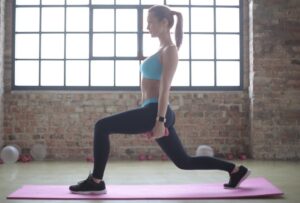An 8 day workout split is one where you plan your training in blocks of eight days. Each block represents a mini training cycle, and you can program these in many ways, depending on your goals, schedule, and preferences.
Instead of looking at the training you must do in a week, you have to look beyond that and plan your sessions in a slightly more extended period. For example, if your first block starts on Monday, it will end on Tuesday the following week.
Leveraging an 8 day split can be beneficial but also make programming difficult. A notable benefit of an 8 day split is that you get more flexibility to move sessions around and try various approaches (push/pull/legs, body part routines, etc.). Your training looks different from week to week, but you still cover all the fundamentals necessary for muscle growth and strength gain. As a result, your training becomes more engaging, and you’re at a smaller risk of getting bored or burned out.
An issue with 8 day splits is that it can be challenging to program your workouts. Each week’s training looks slightly different, making it tricky to stay on track. You should only program your training in 8 day blocks if you’re reasonably experienced and comfortable writing your programs. Our guide will teach you how to do it and give you some programming ideas.
A typical 8 day split consists of six workouts and two rest days. For example, you can train three days in a row, take a break, and repeat to complete one cycle.
The Benefits of the 8 Day Split
One of the greatest advantages of an 8 day split is the emphasis on recovery. Programming your training inside seven days can make it challenging to get enough recovery time before each new session.
An example would be a 6 day split where you train six times per week and only get one day to recover before repeating it.
An 8 day split allows you to spread your training slightly more and give your muscles the time they need to recover. Consider the following 6 day push/pull/legs split:
Monday – Push
Tuesday – Pull
Wednesday – Legs
Thursday – Push
Friday – Pull
Saturday – Legs
Sunday – Off
The above is by no means a bad split, and it can work great for people looking to gain strength and build muscle. But, as mentioned, you only have one day of recovery (Sunday), which can lead to recovery issues after weeks of running the split.
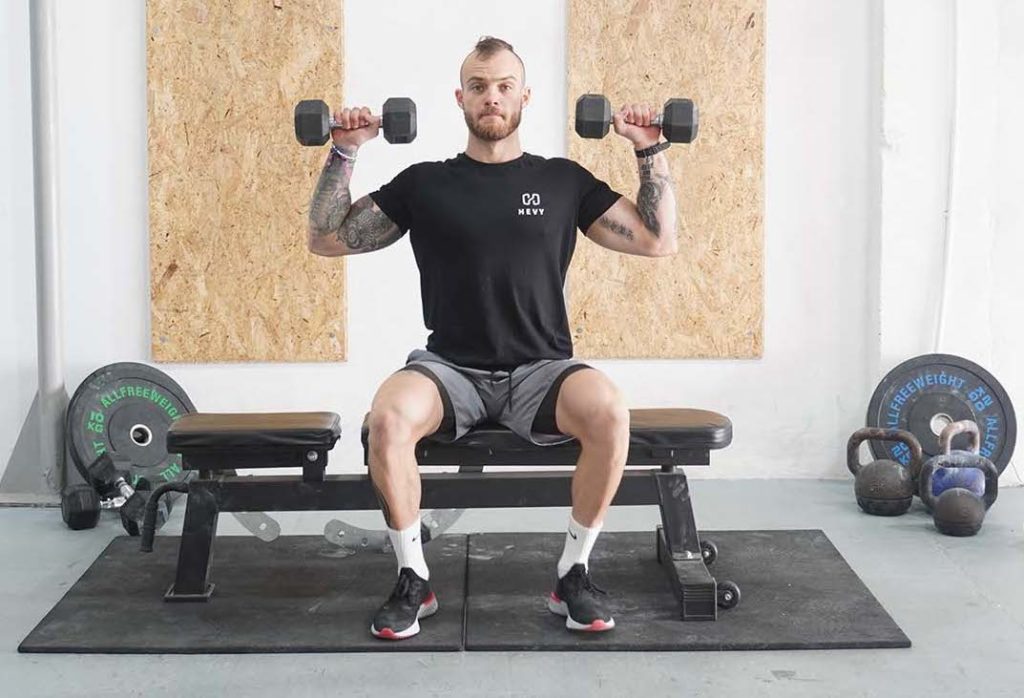
Now, let’s take the same push/pull/legs split but put it inside an 8 day cycle:
Monday – Push
Tuesday – Pull
Wednesday – Legs
Thursday – Off
Friday – Push
Saturday – Pull
Sunday – Legs
Monday – Off
You now have a day of recovery for each mini-block of three workouts. The extra day gives your body more time to repair the exercise-induced damage and allows you to take a mental break from training. As a result, you’re more likely to enjoy your training, have more time for other activities, and can make better progress in the long run.
Is the 8 Day Split Workout Safe?
Like any other training approach, an 8 day split carries some risk, and you must pay careful attention to your body and how it responds to each session. The advantage of an 8 day split compared to high-frequency approaches like a 7 day program is that you have to do fewer consecutive training days, leaving more time for recovery. As such, you’re at a lower risk of running into recovery issues or developing overuse injuries from too much stress on your joints, connective tissues, and muscles.
Aside from being a safe way to program your training, an 8 day split workout is beneficial for providing your body with the necessary stimulus for growth. Recovery is prioritized better, but you still train hard and accumulate the necessary training volume for muscle growth (1). You can also train your muscles more frequently, which appears beneficial for muscle growth and strength gain (2, 3). Using a workout log can help you organize your workouts and rest days.
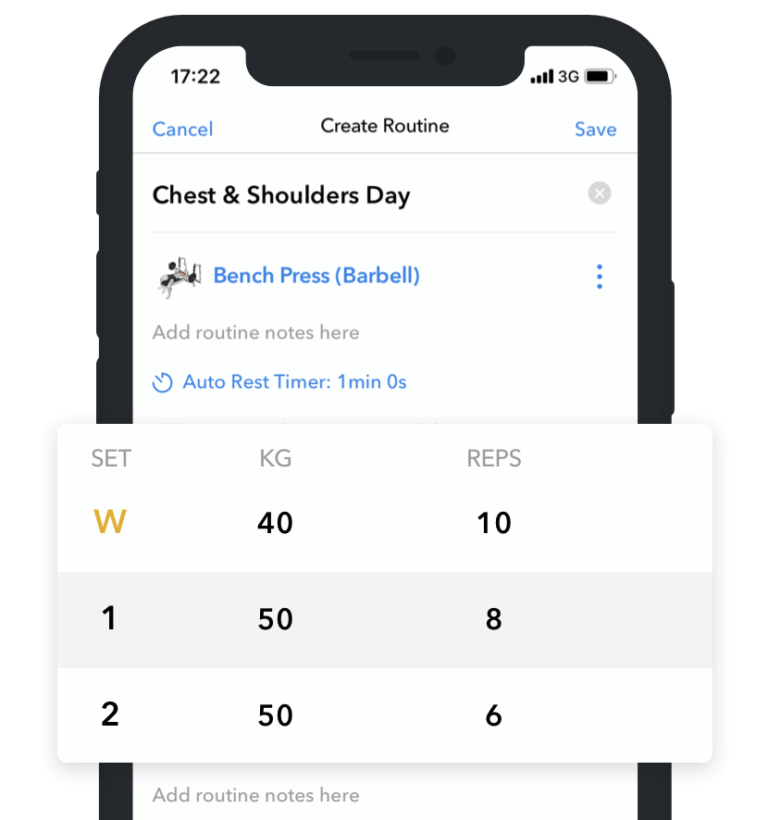
Hevy – Workout Tracker





Hevy – Workout Tracker
Create your own 8 day split with Hevy, and track your progress – for free
An 8 day split benefits more advanced trainees looking to change up their training, overcome a plateau or prioritize recovery. Experienced lifters often try to resolve issues by training harder, but spreading their training over eight days can be the change they need to fix aches, feel better, and start making progress again.
Following an 8 day split might not be suitable for less advanced trainees simply because they don’t need as many weekly workouts to make good progress. Beginners can start with a 2 day split and gradually increase their training frequency as they gain experience. A 4 day split would be ideal for most intermediate lifters simply because there is enough flexibility, trainees can choose from numerous programs, and there is plenty of time for recovery.
The primary thing to be careful with when programming an 8 day split is to avoid doing too much training in any given workout, as that can increase the risk of overtraining. Fewer sets and exercises per session can work even for more advanced trainees because you’re training almost daily and doing more than enough for good progress.
Pros and Cons of the 8 Day Split
Now that we are familiar with 8 day splits and have a basic understanding of the primary benefits and drawbacks, let’s outline all the pros and cons.
| Pros | Cons |
| Greater emphasis on recovery | Programming your training is more challenging |
| High enough training frequency for optimal strength gain | Each training week looks different, making it more challenging to adhere to your plan |
| Enough weekly sessions to accumulate volume for muscle gain (1) | It can be harder to peak for a powerlifting competition |
| Various ways to schedule an 8 day training cycle | You will have to do some of your workouts over Saturday and Sunday |
| You can pick from numerous splits (e.g., push/pull/legs) to put together an 8 day cycle | |
| Training differs from week to week, making the experience more engaging |
Full Body Warm-Up Routine
Warming up is a crucial but overlooked aspect of training. A good warm-up is necessary to optimize your training performance, get you in the mood for training, and reduce the risk of injuries (4, 5).
A warm-up aims to raise your core body temperature, offering several distinct benefits. First, a higher body temperature is necessary for the optimal functioning of enzymes related to energy production (6). Second, warming up improves our muscles’ elastic properties, making us less likely to suffer from a pulled or torn muscle (7). Third, a warm-up allows the synovial fluid to lubricate joints and reduce the friction that can lead to joint-related problems. Plus, a good warm-up can serve as a ritual to get you in the mood for training and boost your motivation.
Here is a simple warm-up routine that takes five to seven minutes to complete:
Side-to-side leg swings
Grab a gym rack or place your hands flat against a wall for balance. Lift one foot off the floor and put your weight on the other. Brace your core and begin swinging your leg gently, moving it out as much as possible and bringing it in front of your body. Do 10 to 15 reps and switch to the other leg.
Leg swings are excellent for warming up your hips and inner thigh muscles.
Deep squat hold
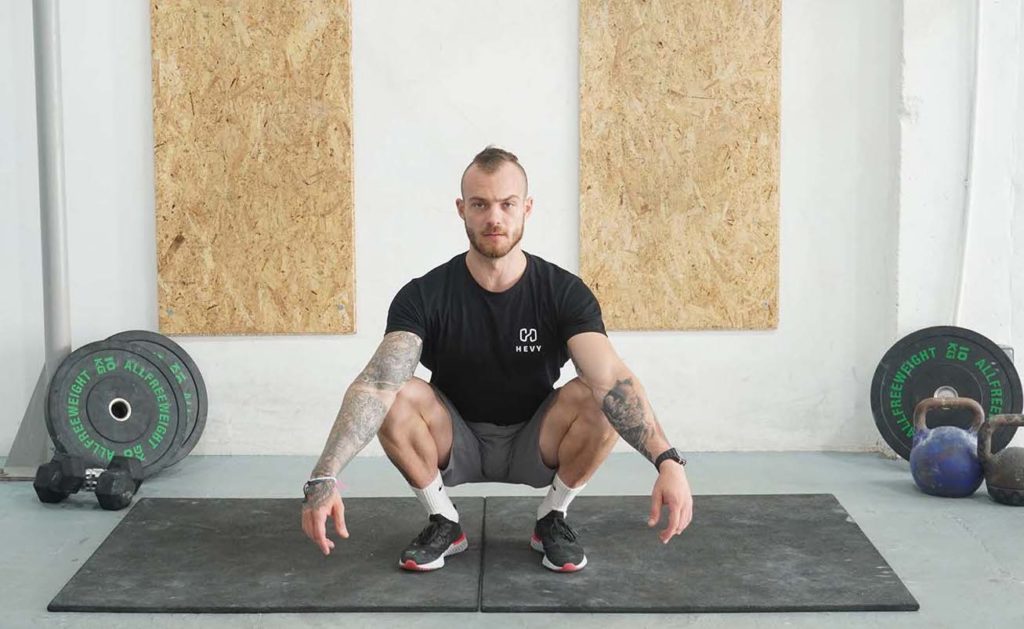

Stand tall with your feet in a comfortable stance and toes pointing slightly out. Take a breath, brace your core, and squat as deep as possible while keeping your heels in contact with the floor. Hold the bottom position for five to seven seconds and ascend, exhaling near the top. Take another breath and repeat 5 to 10 times.
Like leg swings, deep squat holds are fantastic for opening up your hips and stretching your inner thighs.
Jumping Jacks
Stand tall with your feet together, arms straight, and hands to your sides. Take a breath and hop, bringing your feet apart and raising your arms laterally and over your head. Exhale and take another breath as you hop and get your feet together and arms to your sides. Keep alternating at a steady pace for 30 to 60 seconds.
Jumping jacks are excellent for warming up your entire body and engaging most major muscles.
Glute bridges
Lie on the floor, place your hands by your sides, bend your knees, and have your feet flat on the floor. Engage your abs, take a breath, and extend your hips by pushing through your heels and squeezing your glutes. Raise your hips until they are aligned with your shoulders and knees. Hold the top position for two to three seconds and release as you exhale. Take another breath and repeat 10 to 15 more times.
The glute bridge is fantastic for warming up your lower body and improving glute activation.
Thoracic rotations
Assume a lunge position by extending one leg forward, bending the knee, and placing the foot flat on the floor. Your opposite knee should also be in contact with the floor. Straighten your arms, raise them laterally, take a breath, and rotate your torso to one side, moving as much as possible. Hold the position for five seconds and twist your torso in the opposite direction. Keep alternating between left and right until you’ve done at least five reps in both directions.
Lunging thoracic rotations are fantastic for improving your upper back mobility, which is necessary for many exercises.
Muscle Groups that Work Well Together
Synergistic muscle groups work together to produce various movements. A prominent example is the back and biceps that synergize during activities like pull-ups and barbell rows (8).
The chest, shoulders, and triceps are another synergistic group that works as one during exercises like push-ups, dips, and the bench press (9).
Synergistic muscles around the hip joint are the psoas major, iliacus, and rectus femoris. These muscles work together to flex the hip. In contrast to that motion, the glutes and hamstrings work together to extend the hip joint.
Chest, Shoulders, and Triceps
These three muscle groups work together on most ‘push’ exercises. For instance, as you lie on a gym bench and position a barbell over your torso, the chest, shoulders, and triceps engage, allowing you to lower the weight and press it away from yourself (9). The chest muscles are more active at the bottom, whereas the triceps take over near the top of each repetition.
The chest, shoulders, and triceps synergize during push-ups, overhead pressing, incline pressing, and more.
Back, Biceps, and Forearms
These muscle groups synergize to produce various ‘pulling’ motions. One prominent example is the pull-up, where many back muscles work with the biceps and forearms to produce enough force, allowing us to pull ourselves up on a horizontal bar (8). The same goes for other activities, including barbell rows, lat pulldowns, etc.
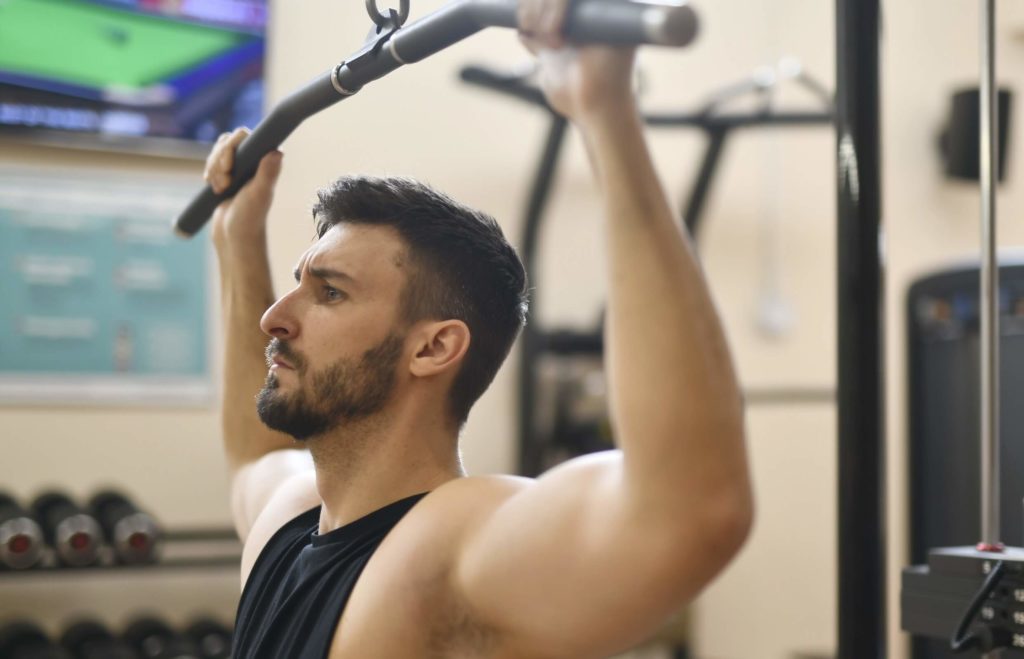

Training the biceps alongside the back is inevitable simply because almost all movements that develop the latissimus dorsi, rhomboids, and other back muscles involve elbow flexion. As such, it’s impossible to isolate the back.
Psoas Major, Iliacus, and Rectus Femoris
These three muscles are collectively referred to as the hip flexors. All three cover the front of our hips and work together to create flexion (i.e., bringing the knees closer to the chest). The psoas major and iliacus are situated higher and form the iliopsoas muscle. In contrast to the pair, the rectus femoris is located slightly lower in relation to the hip and makes up a part of the thigh musculature.
Performing any hip flexion inevitably trains all three muscle groups.
Glutes and hamstrings
In contrast to the hip flexors we reviewed above, the glutes and hamstrings are a pair of synergistic muscles that produce the opposite movement: hip extension. Flexing the glutes drives our hips forward, bringing our knees away from the chest. Similar to how the biceps assist the back musculature, the hamstrings inevitably help the glutes with hip extension. For instance, as you engage your glutes during deadlifts, your hips move forward, and the weight goes up. The hamstrings, back, midsection, and other muscle groups assist.
8 Day Split Workouts
8 Day Split: Push/Pull/Legs
A push/pull/legs split is one where you combine synergistic muscle groups into three distinct workouts. You train your chest, shoulders, and triceps on push day, your back and biceps on pull day, and your lower body during legs. The split works well for people who want to train three days per week, but it can also be fantastic on an 8 day split.
The objective is to perform blocks of three workouts (push, pull, and legs), take a day off, and repeat.
Level: Intermediate
| Day 1 – Push | Day 2 – Pull |
| Bench Press (Barbell) – 3 sets of 6 to 10 reps | Bent Over Row (Barbell) – 3 sets of 6 to 10 reps |
| Seated Shoulder Press (Machine) – 3 sets of 8 to 12 reps | Inverted Row – 3 sets of 5 to 15 reps |
| Skullcrusher (Dumbbell) – 3 sets of 12 to 15 reps | Lat Pulldown (Cable) – 3 sets of 12 to 15 reps |
| Cable Fly Crossover – 3 sets of 12 to 15 reps | Bicep Curl (Machine) – 3 sets of 12 to 15 rep |
| Lateral Raise (Dumbbell) – 2-3 sets of 15 to 20 reps | Face Pull – 3 sets of 15 to 25 reps |
| Day 3 – Legs | Day 4 – Off |
| Squat (Barbell) – 3 sets of 6 to 10 reps | Light cardio for 15 to 30 minutes (if you feel up to it). |
| Glute Ham Raise – 3 sets of 6 to 15 reps | Stretching tight areas for 5-10 minutes in the morning and evening. |
| Leg Extension (Machine) – 3 sets of 12 to 15 reps | Walking at least 5,000 steps. |
| Seated Calf Raise – 3 sets of 15 to 20 reps |
| Day 5 – Push | Day 6 – Pull |
| Overhead Press (Barbell) – 3 sets of 6 to 10 reps | Meadows Rows (Barbell) – 3 sets of 8 to 12 reps |
| Incline Bench Press (Dumbbell) – 3 sets of 8 to 12 reps | Seated Cable Row – 3 sets of 12 to 15 reps |
| Triceps Rope Pushdown – 3 sets of 12 to 15 reps | Shrug (Dumbbell) – 3 sets of 10 to 15 reps |
| Chest Press (Machine) – 3 sets of 12 to 15 reps | Concentration Curl – 3 sets of 12 to 20 reps |
| Plate Front Raise – 3 sets of 15 to 20 reps |
| Day 7 – Legs | Day 8 – Off |
| Hip Thrust (Barbell) – 3 sets of 6 to 10 reps | Light cardio for 15 to 30 minutes (if you feel up to it). |
| Goblet Squat – 3 sets of 8 to 12 reps | Stretching tight areas for 5-10 minutes in the morning and evening. |
| Romanian Deadlift (Dumbbell) – 3 sets of 10 to 15 reps | Walking at least 5,000 steps. |
| Standing Calf Raise (Machine) – 3 sets of 8 to 15 reps |
Schedule:
Monday – Push
Tuesday – Pull
Wednesday – Legs
Thursday – Off
Friday – Push
Saturday – Pull
Sunday – Legs
Monday – Off
8 Day Split: Body Part (Bro) Split
The bro split works excellent on an 8 day cycle because you can approach it in many ways and pair muscle groups however you’d like. You can also introduce some ‘power’ or ‘strength’ days, emphasize weak points by doing more sets, and change up your 8 day schedule to keep things engaging.


An 8 day bro split also works better than traditional options such as a 5 day split because you can train muscle groups more frequently.
Level: Beginner/Intermediate
| Day 1 – Chest and Triceps | Day 2 – Back and Biceps |
| Bench Press (Barbell) – 4 sets of 6 to 10 reps | Bent Over Row (Barbell) – 3 sets of 6 to 10 reps |
| Incline Bench Press (Dumbbell) – 3 sets of 8 to 12 reps | Seated Cable Row – 3 sets of 12 to 15 reps |
| Cable Fly Crossover – 3 sets of 12 to 15 reps | Shrug (Dumbbell) – 3 sets of 10 to 15 reps |
| Skullcrusher (Dumbbell) – 3 sets of 12 to 15 reps | Bicep Curl (Machine) – 3 sets of 12 to 15 rep |
| One Arm tricep Extension (Dumbbell) – 2-3 sets of 12 to 20 reps (per arm) | Face Pull – 3 sets of 15 to 25 reps |
| Day 3 – Shoulders and Legs | Day 4 – Off |
| Overhead Press (Barbell) – 3 sets of 6 to 10 reps | Light cardio for 15 to 30 minutes (if you feel up to it). |
| Glute Ham Raise – 3 sets of 6 to 15 reps | Stretching tight areas for 5-10 minutes in the morning and evening. |
| Lateral Raise (Dumbbell) – 2-3 sets of 15 to 20 reps | Walking at least 5,000 steps. |
| Leg Extension (Machine) – 3 sets of 12 to 15 reps | |
| Plate Front Raise – 3 sets of 15 to 20 reps | |
| Seated Calf Raise – 3 sets of 15 to 20 reps |
| Day 5 – Chest and Shoulders | Day 6 – Back and Biceps |
| Chest Dip – 3 sets of 6 to 15 reps | Inverted Row – 3 sets of 5 to 15 reps |
| Incline Bench Press (Dumbbell) – 3 sets of 8 to 12 reps | Meadows Rows (Barbell) – 3 sets of 8 to 12 reps |
| Chest Press (Machine) – 3 sets of 12 to 15 reps | Lat Pulldown (Cable) – 3 sets of 12 to 15 reps |
| Seated Shoulder Press (Machine) – 3 sets of 8 to 12 reps | Hammer Curl (Dumbbell) – 2-3 sets of 12 to 15 reps |
| Front Raise (Cable) – 2-3 sets of 12 to 15 reps | Concentration Curl – 3 sets of 12 to 20 reps |
| Day 7 – Legs and Triceps | Day 8 – Off |
| Squat (Barbell) – 3 sets of 6 to 10 reps | Light cardio for 15 to 30 minutes (if you feel up to it). |
| Romanian Deadlift (Dumbbell) – 3 sets of 10 to 15 reps | Stretching tight areas for 5-10 minutes in the morning and evening. |
| Goblet Squat – 3 sets of 8 to 12 reps | Walking at least 5,000 steps. |
| Triceps Rope Pushdown – 3 sets of 12 to 15 reps | |
| Standing Calf Raise (Machine) – 3 sets of 8 to 15 reps | |
| Triceps Kickback – 2-3 sets of 12 to 20 reps |
Schedule:
Monday – Chest and Triceps
Tuesday – Back and Biceps
Wednesday – Shoulders and Legs
Thursday – Off
Friday – Chest and Shoulders
Saturday – Back and Biceps
Sunday – Legs and Triceps
Monday – Off
Integrating Cardio into the 8 Day Split
Many trainees skip cardio because they see it as dull and unnecessary. But, including aerobic exercise in your training can improve your work capacity, promote recovery, and boost your training performance (10). Despite not seeming aerobically taxing, intense activities like weight training depend on oxygen significantly (11). You could struggle to improve your performance for long-term muscle gain if you don’t develop your cardiovascular health.
The great news is that 8 day splits leave more than enough room for cardiovascular exercise without impairing your recovery or gym gains. One of the most practical ways to include cardio is one we’ve mentioned above: do some on your off days. You can start with as little as 15 to 30 minutes of light activity and gradually bump the intensity or duration over the upcoming months. Remember to keep your cardio somewhat limited because doing too much or at too high an intensity can interfere with your recovery, muscle growth, and strength gain (12).
Another option is to do cardio on the days when you lift weights but space the two at least six hours apart. For instance, you can do cardio in the morning and weight train in the evening. If that doesn’t work, you can do your lifting first and finish off with 15 to 30 minutes of cardio.


Avoid doing more than an hour of cardio per week initially. That duration will be more than enough to support aerobic health and promote recovery.
You can pick from a range of activities for your cardio but be mindful of how each impacts your recovery. Running is a popular option, but it might not work well if your legs get too sore for squatting, deadlifting, and such. Riding a bike or an elliptical trainer is less demanding and poses a much smaller risk. Walking is also a good form of low-impact cardio (13). For instance, you can download a phone app and aim for at least 5,000 steps daily.
The Importance of Rest Days
Training stresses your muscles, bones, joints, and connective tissues, and your body needs time to repair the tissue damage after each session to adapt positively. Failing to do that would mean you’re in a state of under-recovery and more likely to get injured or burned out.
Theoretically, you can structure your training in a way where you work out daily and still give each muscle group at least 48 hours to recover. Unfortunately, that alone isn’t enough because the other tissues often need more time to recover, and placing too much stress on them for too long can result in overuse injuries (14).
Rest days are brief breaks from strenuous training that give your body more time to repair all the damage, leading to positive adaptations (i.e., strength, muscle, endurance, etc.). As a result, you can make better progress, experience fewer injuries, and feel more energized.
The 8 day split does an excellent job incorporating rest days while having you train frequently enough for optimal progress. You train for three consecutive days, followed by a physical and mental break from the gym. If you structure your training intelligently, eat well, and get plenty of sleep, that should be enough to recover well between workouts.
Your objective during rest days should be to avoid strenuous physical activity that can limit your recovery. Some acceptable activities include light cardio (jogging, bike riding, swimming, etc.), stretching, and walking. Rest days are the perfect opportunity to decompress, promote active recovery, and work on your mobility and flexibility.
Tips on Proper Recovery
Nutrition
- Maintain a small surplus of 150 to 300 calories, aiming to gain 1 to 1.5 percent of your body weight each month.
- Consume at least 0.7 grams of protein per pound of body weight daily (15). Good sources include meat, fish, poultry, eggs, cottage cheese, and protein powder supplements.
- Eat plenty of complex carbs to support recovery and your gym performance (16). Healthy options include fruits, vegetables, and grains.
- Get 0.35 to 0.45 grams of fats per pound of body weight. The nutrient is necessary for good health and processes related to your fitness progress (17). Avocado, eggs, olive oil, and nuts are all excellent sources.
Sleep


- Get at least seven hours of sleep per night.
- Avoid drinking too many liquids in the evening, as that can cause you to break up your sleep by going to the bathroom at night.
- Limit screen time in the evening and consider less stimulating activities like reading a book, journaling, writing a to-do list, meditating, and stretching.
- Avoid caffeine within six to eight hours of bedtime because the stimulant can interfere with your sleep (18).
- Invest in a quality mattress and pillow: they make a huge difference.
Massage
- Some data suggests that massages are a fantastic way to improve post-training recovery and reduce muscle soreness (19, 20).
- If possible, go for a massage once or twice a month.
- Self-myofascial release with a foam roller or a lacrosse ball can have a similar effect, but it takes more effort, and releasing tight spots can be tricky.
Stretching
- Static stretching can be a helpful tactic for improving your recovery. It promotes blood flow to your muscles, supplying them with more oxygen and nutrients.
- You can stretch your muscles after working out as a form of a cooldown. Alternatively, set up a simple stretching routine for your mornings or evenings.
- Stretch all the major areas in your body: neck, pectorals, back, hips and groin, quadriceps, and hamstrings.
- Perform a variety of stretches, and don’t be afraid to experiment with different movements.
- Hold each stretch for 10 to 60 seconds and keep them moderately uncomfortable. Avoid stretching your muscles to the point of actual pain.
Things to avoid
- Taking every set to failure. Doing so might seem great for making progress, but pushing yourself to your limits leads to more fatigue and makes it more challenging to recover (21).
- Consuming too much alcohol. While the occasional beer won’t harm you, some research finds that excessive alcohol consumption can hinder testosterone production and muscle protein rates, possibly leading to slower recovery (22).
- Not drinking enough water is also something that can impair recovery. While hydration might not seem crucial, the adult human body consists of 60 percent water. Staying hydrated promotes recovery on many fronts, contributes to our well-being, and allows us to perform better at the gym (23).
8 Day Split Vs. 6 Day Split
An 8 day split is where you program your training in blocks of 8 days instead of the traditional seven (a week). The primary way to do it would be to have six workouts and two recovery days. For example:
Monday – train
Tuesday – train
Wednesday – train
Thursday – off
Friday – train
Saturday – train
Sunday – train
Monday – off
You earn a recovery day for every three workouts completed. Once finished with one cycle, you begin the next and your weekly training schedule changes gradually from week to week.
The beauty of an 8 day split is that you get plenty of rest but still train frequently enough to do the necessary sets for optimal growth. You also train often, promoting strength and muscle gain (2, 3).
A 6 day split is similar to an 8 day one in many ways. For one, both splits allow you to leverage various training configurations: push/pull/legs, body part, and more. You can organize your training in many ways to keep things fresh and engaging. Second, both options are high-frequency and best suited for intermediate and advanced trainees. People new to training would be better off with a less demanding split simply because they don’t need to work out as much to make optimal progress.
A drawback of 6 day splits is that you get fewer recovery days, which can increase the risk of overtraining or burnout. Consider the training configurations we saw a few paragraphs earlier but applied to a 6 day split. It would look like this:
Monday – train
Tuesday – train
Wednesday – train
Thursday – train
Friday – train
Saturday – train
Sunday – off
You don’t get that mid-week recovery day because you force yourself to program your training inside seven days. Sacrificing the rigid week-to-week structure gives you more time to recover and still make great progress.
8 Day Split Vs. 7 Day Split
A 7 day split is a form of daily training where you strive to do some form of resistance exercise daily. Doing so can be beneficial for various reasons, but can also lead to recovery issues if you’re not careful.
A prominent benefit of 7 day splits is that you’re doing some form of structured training each day, which can be beneficial for making fitness a part of your life and not losing momentum. Daily workouts are also suitable for boosting your mood, being more productive at work, and feeling great throughout the week.
The primary issue with a 7 day split is that it can be physically and mentally demanding. Doing some form of training might sound great at first, but many people begin to feel overwhelmed after a while and simply need to take a break.
One beneficial way to avoid burning out or overtraining is to manage your per-session training volume. Do a handful of exercises and keep your sets between 10 and 15 on most days to avoid becoming too tired. That way, you can enjoy quicker sessions and still make great progress.
We also recommend having an active recovery day each week. Instead of doing a traditional gym workout, focus on activities like cardio and stretching. Doing so will keep you active and promote recovery without stressing your muscles. You can read more about structuring an excellent 7 day split in our guide.
An 8 day split is similar because you train frequently and have active recovery days to avoid overtraining. Plan, create and log your workouts using the Hevy app.





Hevy – Workout Tracker





Hevy – Workout Tracker
Create your own 8 day split with Hevy, and track your progress – for free
Final Thoughts on the 8 Day Split Workout
An 8 day split is an approach where you program your training in mini-blocks of eight days instead of the traditional seven. As a result, your training schedule changes from week to week, and you often have to train over the weekend. But, an 8 day configuration provides you with more days for recovery, which is essential for staying healthy in the long run and making good fitness progress.
The primary way to do an 8 day split is to train for six days and have two active recovery days. You should train for three consecutive days, do an active recovery day, and repeat to complete each 8 day block. Once finished, begin the next block and run the split for up to ten weeks before deloading or taking an entire week off training.
A significant benefit of an 8 day split is that you can organize your workouts by following the principles of push/pull/legs, body-part-split workouts, and more. You also train your muscles more frequently and do enough sets to optimize muscle gain. An 8 day split also allows you to introduce principles of daily undulated periodization (DUP), where you vary the volume and intensity daily. For example, you can do a heavy leg day for strength gains and follow it up with a hypertrophy lower body workout a few days later. Alternating between the two would allow you to build mass and get stronger simultaneously.
An 8 day split is an excellent way to organize your training, maintain a high frequency, and recover well. Intermediate and advanced trainees who struggle to make good progress with a 5 or 6 day split could consider an 8 day program to freshen things up and get better results.



